Procurement Management Plan: EHR Data Migration Project Analysis
VerifiedAdded on 2023/01/19
|6
|1105
|77
Project
AI Summary
This project management assignment focuses on the procurement plan for an Electronic Health Record (EHR) data migration project. The solution outlines the cost determination process, which relies on a Request for Quote (RFQ) method and considers human resource costs calculated hourly. It details standardized procurement documentation, emphasizing the use of soft copies and the responsibilities of the internal Project Manager and the Purchasing department. The assignment also identifies procurement constraints, including schedule, technical issues, and resource limitations, and suggests mitigation strategies such as detailed project planning, technical expertise, and careful resource allocation. The project aims to securely transfer patient data from a legacy system to a new EHR system, involving various stakeholders and procurement activities, managed by an external vendor. The project highlights the importance of effective procurement management for the successful and timely completion of the data migration.
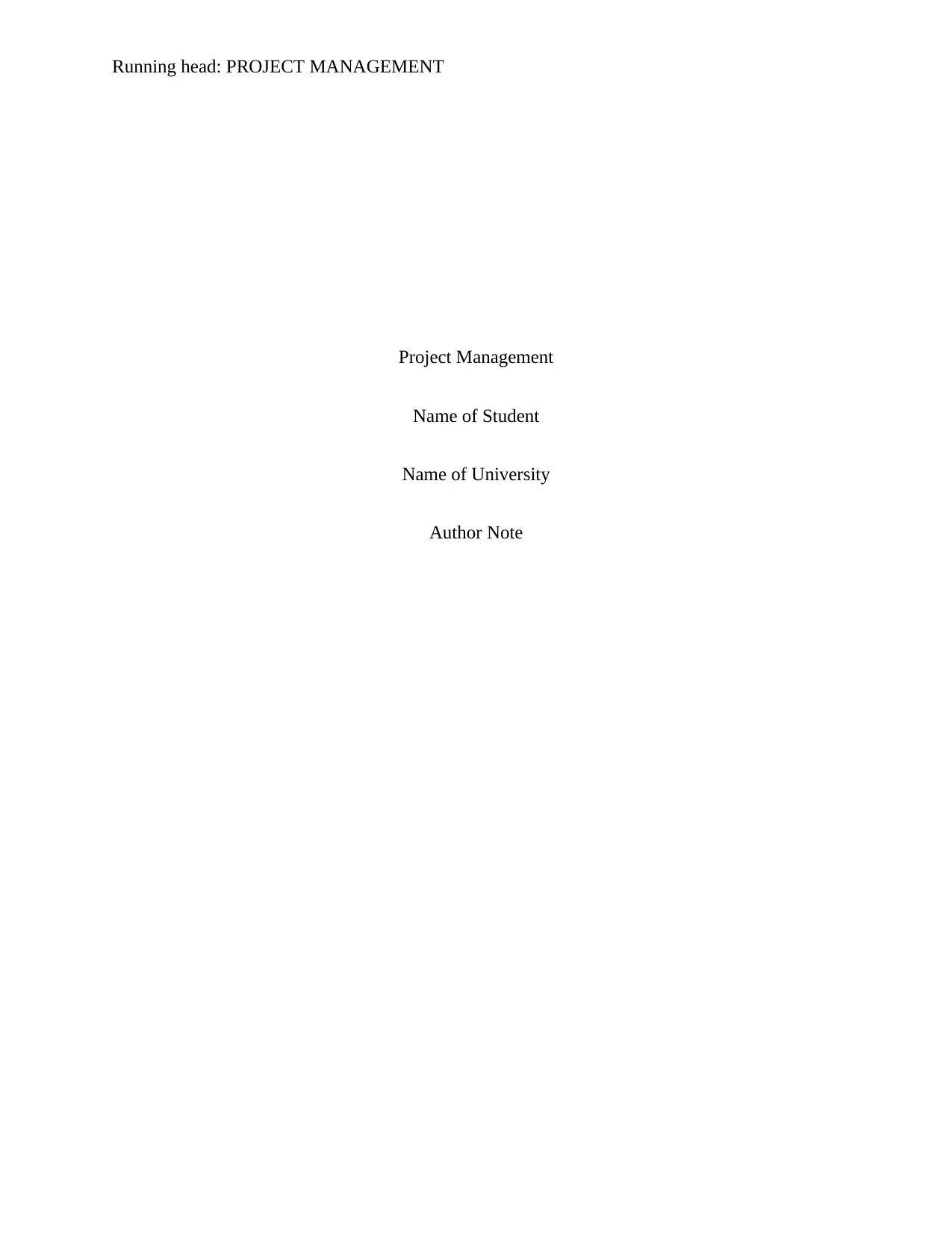
Running head: PROJECT MANAGEMENT
Project Management
Name of Student
Name of University
Author Note
Project Management
Name of Student
Name of University
Author Note
Paraphrase This Document
Need a fresh take? Get an instant paraphrase of this document with our AI Paraphraser
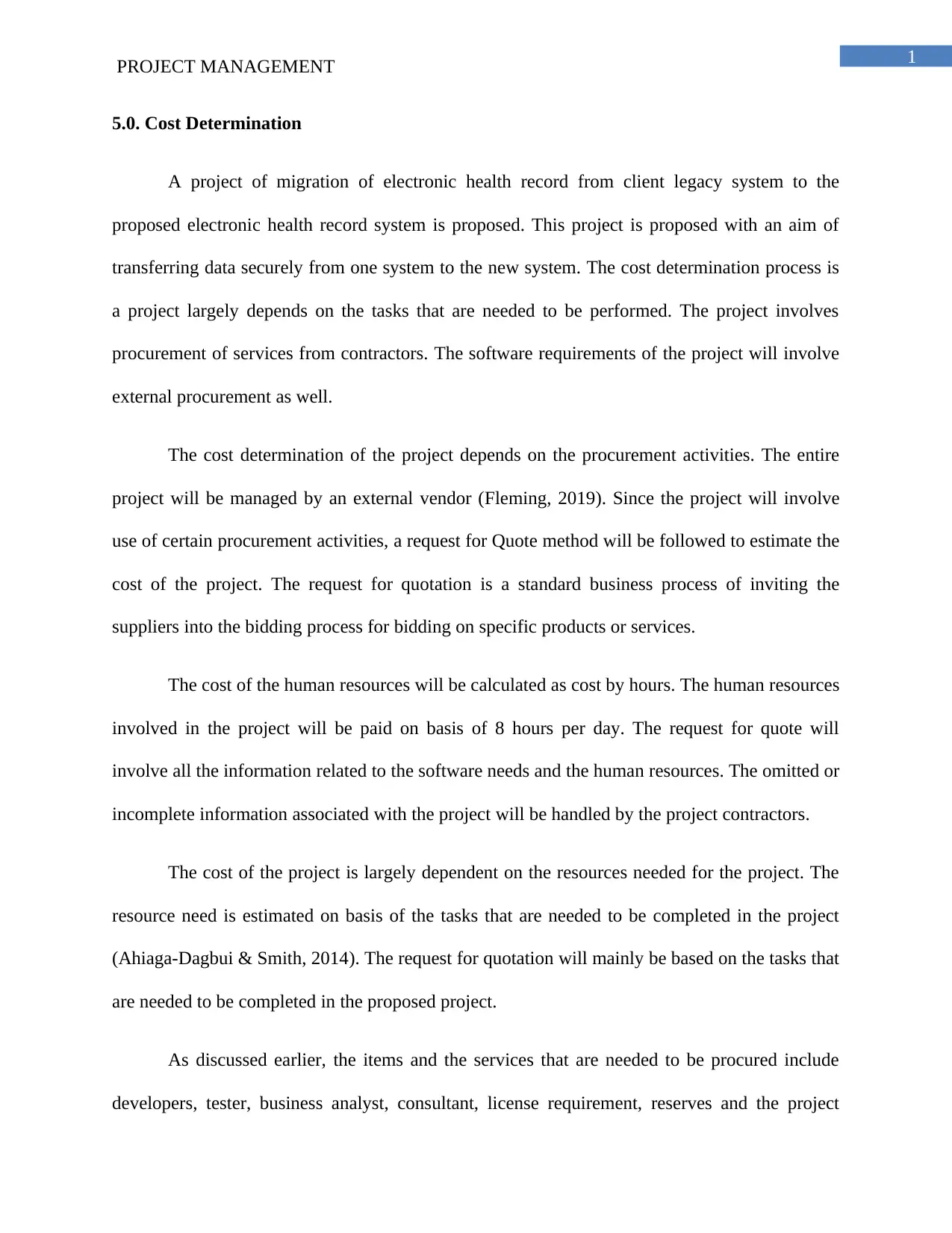
1
PROJECT MANAGEMENT
5.0. Cost Determination
A project of migration of electronic health record from client legacy system to the
proposed electronic health record system is proposed. This project is proposed with an aim of
transferring data securely from one system to the new system. The cost determination process is
a project largely depends on the tasks that are needed to be performed. The project involves
procurement of services from contractors. The software requirements of the project will involve
external procurement as well.
The cost determination of the project depends on the procurement activities. The entire
project will be managed by an external vendor (Fleming, 2019). Since the project will involve
use of certain procurement activities, a request for Quote method will be followed to estimate the
cost of the project. The request for quotation is a standard business process of inviting the
suppliers into the bidding process for bidding on specific products or services.
The cost of the human resources will be calculated as cost by hours. The human resources
involved in the project will be paid on basis of 8 hours per day. The request for quote will
involve all the information related to the software needs and the human resources. The omitted or
incomplete information associated with the project will be handled by the project contractors.
The cost of the project is largely dependent on the resources needed for the project. The
resource need is estimated on basis of the tasks that are needed to be completed in the project
(Ahiaga-Dagbui & Smith, 2014). The request for quotation will mainly be based on the tasks that
are needed to be completed in the proposed project.
As discussed earlier, the items and the services that are needed to be procured include
developers, tester, business analyst, consultant, license requirement, reserves and the project
PROJECT MANAGEMENT
5.0. Cost Determination
A project of migration of electronic health record from client legacy system to the
proposed electronic health record system is proposed. This project is proposed with an aim of
transferring data securely from one system to the new system. The cost determination process is
a project largely depends on the tasks that are needed to be performed. The project involves
procurement of services from contractors. The software requirements of the project will involve
external procurement as well.
The cost determination of the project depends on the procurement activities. The entire
project will be managed by an external vendor (Fleming, 2019). Since the project will involve
use of certain procurement activities, a request for Quote method will be followed to estimate the
cost of the project. The request for quotation is a standard business process of inviting the
suppliers into the bidding process for bidding on specific products or services.
The cost of the human resources will be calculated as cost by hours. The human resources
involved in the project will be paid on basis of 8 hours per day. The request for quote will
involve all the information related to the software needs and the human resources. The omitted or
incomplete information associated with the project will be handled by the project contractors.
The cost of the project is largely dependent on the resources needed for the project. The
resource need is estimated on basis of the tasks that are needed to be completed in the project
(Ahiaga-Dagbui & Smith, 2014). The request for quotation will mainly be based on the tasks that
are needed to be completed in the proposed project.
As discussed earlier, the items and the services that are needed to be procured include
developers, tester, business analyst, consultant, license requirement, reserves and the project
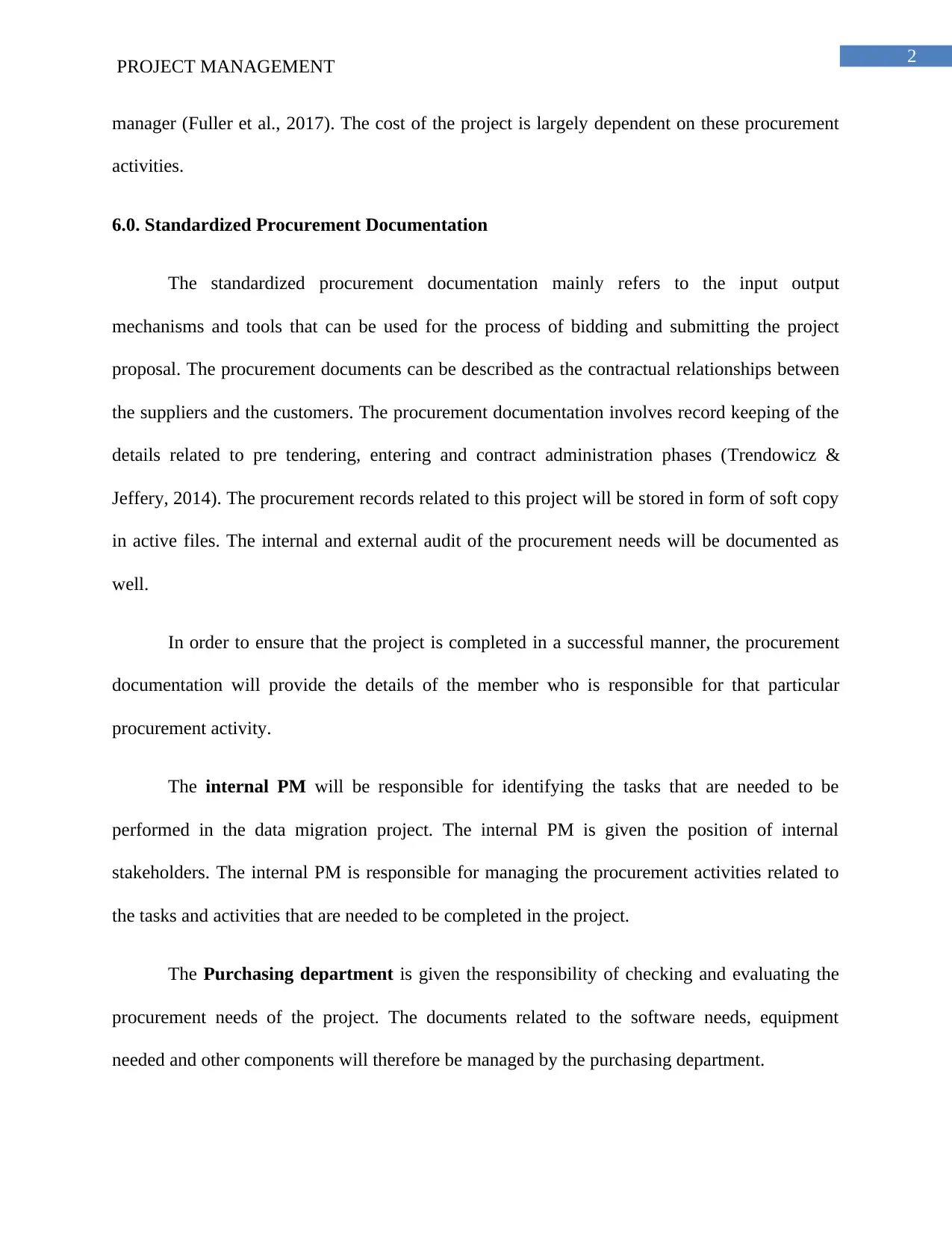
2
PROJECT MANAGEMENT
manager (Fuller et al., 2017). The cost of the project is largely dependent on these procurement
activities.
6.0. Standardized Procurement Documentation
The standardized procurement documentation mainly refers to the input output
mechanisms and tools that can be used for the process of bidding and submitting the project
proposal. The procurement documents can be described as the contractual relationships between
the suppliers and the customers. The procurement documentation involves record keeping of the
details related to pre tendering, entering and contract administration phases (Trendowicz &
Jeffery, 2014). The procurement records related to this project will be stored in form of soft copy
in active files. The internal and external audit of the procurement needs will be documented as
well.
In order to ensure that the project is completed in a successful manner, the procurement
documentation will provide the details of the member who is responsible for that particular
procurement activity.
The internal PM will be responsible for identifying the tasks that are needed to be
performed in the data migration project. The internal PM is given the position of internal
stakeholders. The internal PM is responsible for managing the procurement activities related to
the tasks and activities that are needed to be completed in the project.
The Purchasing department is given the responsibility of checking and evaluating the
procurement needs of the project. The documents related to the software needs, equipment
needed and other components will therefore be managed by the purchasing department.
PROJECT MANAGEMENT
manager (Fuller et al., 2017). The cost of the project is largely dependent on these procurement
activities.
6.0. Standardized Procurement Documentation
The standardized procurement documentation mainly refers to the input output
mechanisms and tools that can be used for the process of bidding and submitting the project
proposal. The procurement documents can be described as the contractual relationships between
the suppliers and the customers. The procurement documentation involves record keeping of the
details related to pre tendering, entering and contract administration phases (Trendowicz &
Jeffery, 2014). The procurement records related to this project will be stored in form of soft copy
in active files. The internal and external audit of the procurement needs will be documented as
well.
In order to ensure that the project is completed in a successful manner, the procurement
documentation will provide the details of the member who is responsible for that particular
procurement activity.
The internal PM will be responsible for identifying the tasks that are needed to be
performed in the data migration project. The internal PM is given the position of internal
stakeholders. The internal PM is responsible for managing the procurement activities related to
the tasks and activities that are needed to be completed in the project.
The Purchasing department is given the responsibility of checking and evaluating the
procurement needs of the project. The documents related to the software needs, equipment
needed and other components will therefore be managed by the purchasing department.
⊘ This is a preview!⊘
Do you want full access?
Subscribe today to unlock all pages.

Trusted by 1+ million students worldwide
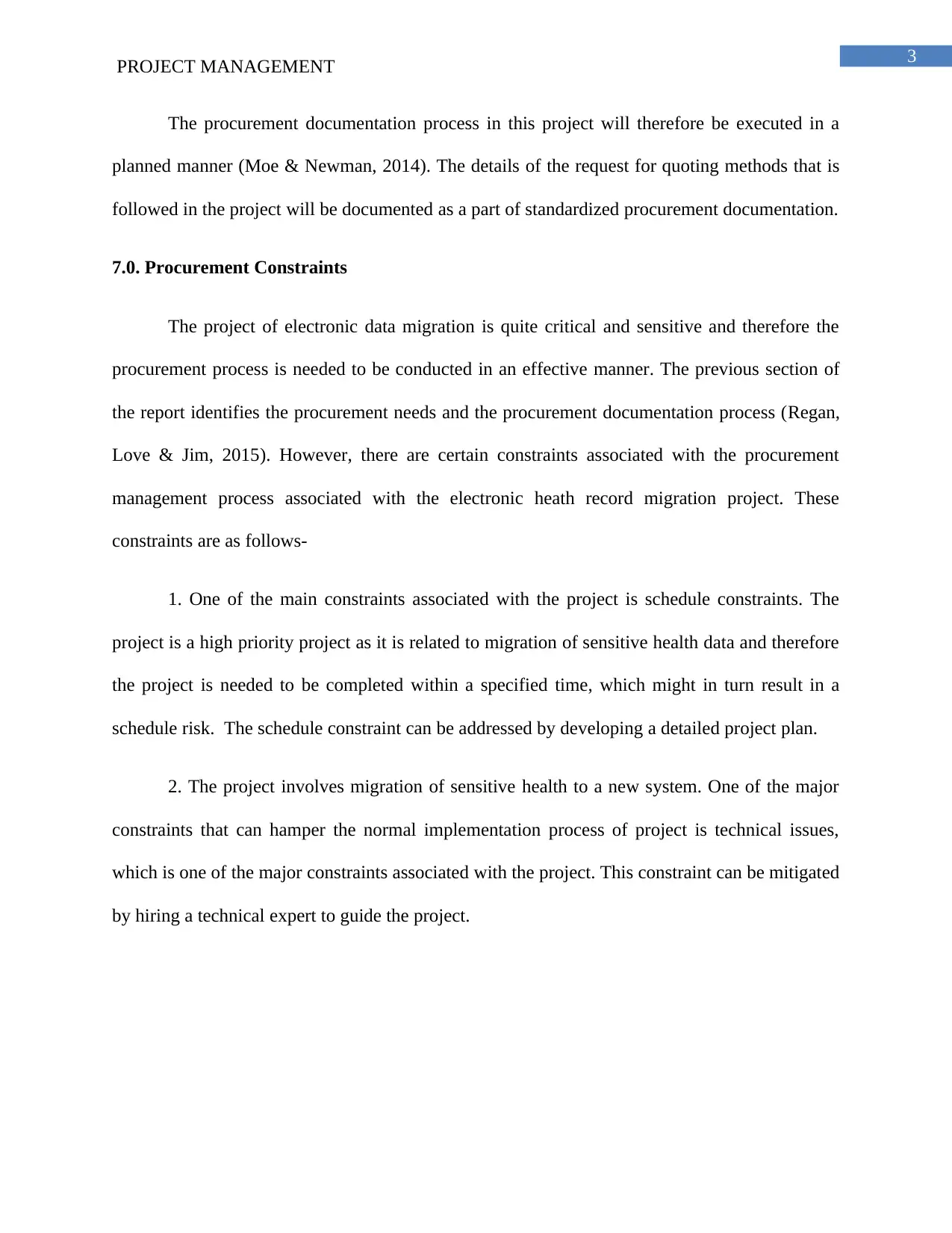
3
PROJECT MANAGEMENT
The procurement documentation process in this project will therefore be executed in a
planned manner (Moe & Newman, 2014). The details of the request for quoting methods that is
followed in the project will be documented as a part of standardized procurement documentation.
7.0. Procurement Constraints
The project of electronic data migration is quite critical and sensitive and therefore the
procurement process is needed to be conducted in an effective manner. The previous section of
the report identifies the procurement needs and the procurement documentation process (Regan,
Love & Jim, 2015). However, there are certain constraints associated with the procurement
management process associated with the electronic heath record migration project. These
constraints are as follows-
1. One of the main constraints associated with the project is schedule constraints. The
project is a high priority project as it is related to migration of sensitive health data and therefore
the project is needed to be completed within a specified time, which might in turn result in a
schedule risk. The schedule constraint can be addressed by developing a detailed project plan.
2. The project involves migration of sensitive health to a new system. One of the major
constraints that can hamper the normal implementation process of project is technical issues,
which is one of the major constraints associated with the project. This constraint can be mitigated
by hiring a technical expert to guide the project.
PROJECT MANAGEMENT
The procurement documentation process in this project will therefore be executed in a
planned manner (Moe & Newman, 2014). The details of the request for quoting methods that is
followed in the project will be documented as a part of standardized procurement documentation.
7.0. Procurement Constraints
The project of electronic data migration is quite critical and sensitive and therefore the
procurement process is needed to be conducted in an effective manner. The previous section of
the report identifies the procurement needs and the procurement documentation process (Regan,
Love & Jim, 2015). However, there are certain constraints associated with the procurement
management process associated with the electronic heath record migration project. These
constraints are as follows-
1. One of the main constraints associated with the project is schedule constraints. The
project is a high priority project as it is related to migration of sensitive health data and therefore
the project is needed to be completed within a specified time, which might in turn result in a
schedule risk. The schedule constraint can be addressed by developing a detailed project plan.
2. The project involves migration of sensitive health to a new system. One of the major
constraints that can hamper the normal implementation process of project is technical issues,
which is one of the major constraints associated with the project. This constraint can be mitigated
by hiring a technical expert to guide the project.
Paraphrase This Document
Need a fresh take? Get an instant paraphrase of this document with our AI Paraphraser
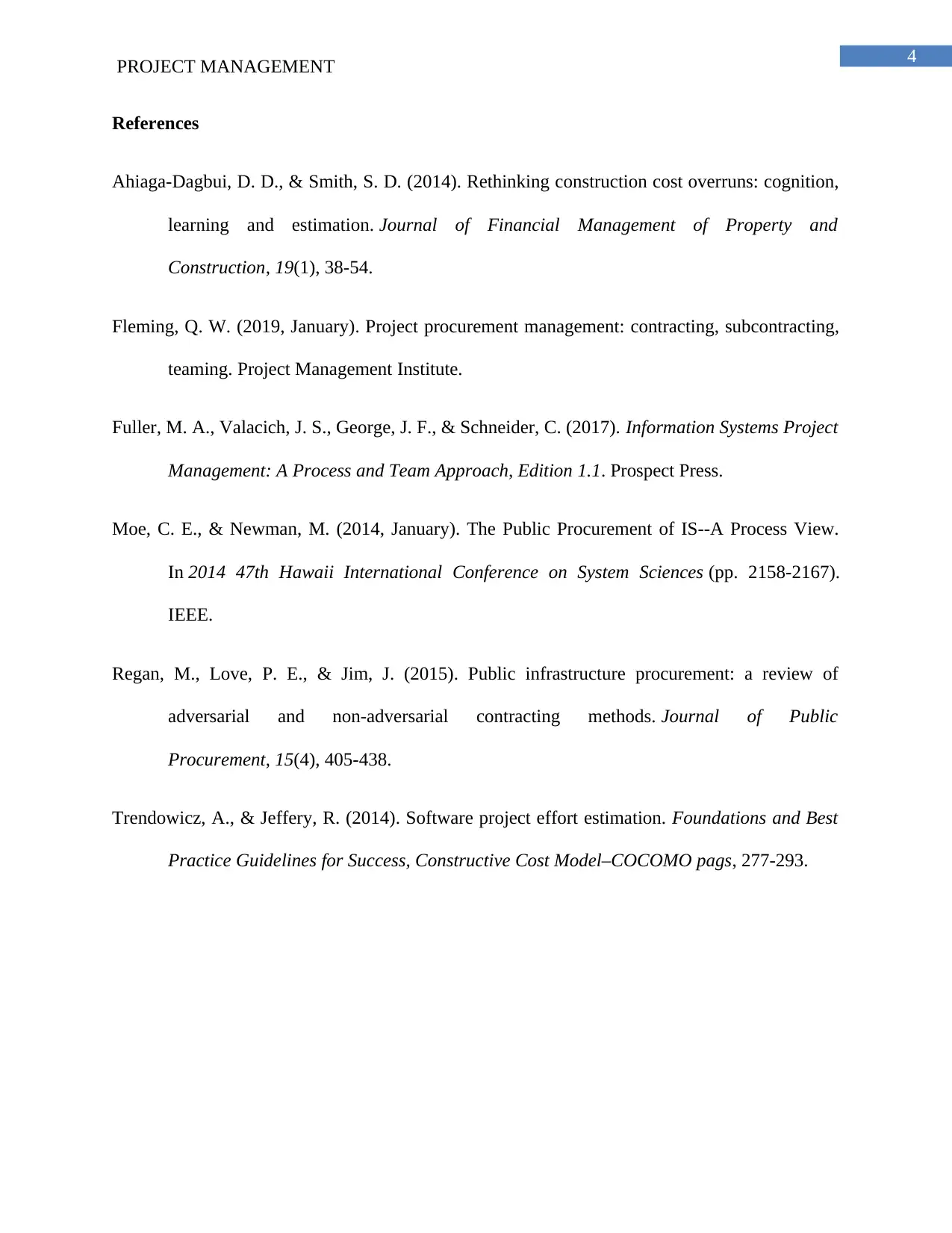
4
PROJECT MANAGEMENT
References
Ahiaga-Dagbui, D. D., & Smith, S. D. (2014). Rethinking construction cost overruns: cognition,
learning and estimation. Journal of Financial Management of Property and
Construction, 19(1), 38-54.
Fleming, Q. W. (2019, January). Project procurement management: contracting, subcontracting,
teaming. Project Management Institute.
Fuller, M. A., Valacich, J. S., George, J. F., & Schneider, C. (2017). Information Systems Project
Management: A Process and Team Approach, Edition 1.1. Prospect Press.
Moe, C. E., & Newman, M. (2014, January). The Public Procurement of IS--A Process View.
In 2014 47th Hawaii International Conference on System Sciences (pp. 2158-2167).
IEEE.
Regan, M., Love, P. E., & Jim, J. (2015). Public infrastructure procurement: a review of
adversarial and non-adversarial contracting methods. Journal of Public
Procurement, 15(4), 405-438.
Trendowicz, A., & Jeffery, R. (2014). Software project effort estimation. Foundations and Best
Practice Guidelines for Success, Constructive Cost Model–COCOMO pags, 277-293.
PROJECT MANAGEMENT
References
Ahiaga-Dagbui, D. D., & Smith, S. D. (2014). Rethinking construction cost overruns: cognition,
learning and estimation. Journal of Financial Management of Property and
Construction, 19(1), 38-54.
Fleming, Q. W. (2019, January). Project procurement management: contracting, subcontracting,
teaming. Project Management Institute.
Fuller, M. A., Valacich, J. S., George, J. F., & Schneider, C. (2017). Information Systems Project
Management: A Process and Team Approach, Edition 1.1. Prospect Press.
Moe, C. E., & Newman, M. (2014, January). The Public Procurement of IS--A Process View.
In 2014 47th Hawaii International Conference on System Sciences (pp. 2158-2167).
IEEE.
Regan, M., Love, P. E., & Jim, J. (2015). Public infrastructure procurement: a review of
adversarial and non-adversarial contracting methods. Journal of Public
Procurement, 15(4), 405-438.
Trendowicz, A., & Jeffery, R. (2014). Software project effort estimation. Foundations and Best
Practice Guidelines for Success, Constructive Cost Model–COCOMO pags, 277-293.

5
PROJECT MANAGEMENT
PROJECT MANAGEMENT
⊘ This is a preview!⊘
Do you want full access?
Subscribe today to unlock all pages.

Trusted by 1+ million students worldwide
1 out of 6
Related Documents
Your All-in-One AI-Powered Toolkit for Academic Success.
+13062052269
info@desklib.com
Available 24*7 on WhatsApp / Email
![[object Object]](/_next/static/media/star-bottom.7253800d.svg)
Unlock your academic potential
Copyright © 2020–2025 A2Z Services. All Rights Reserved. Developed and managed by ZUCOL.





